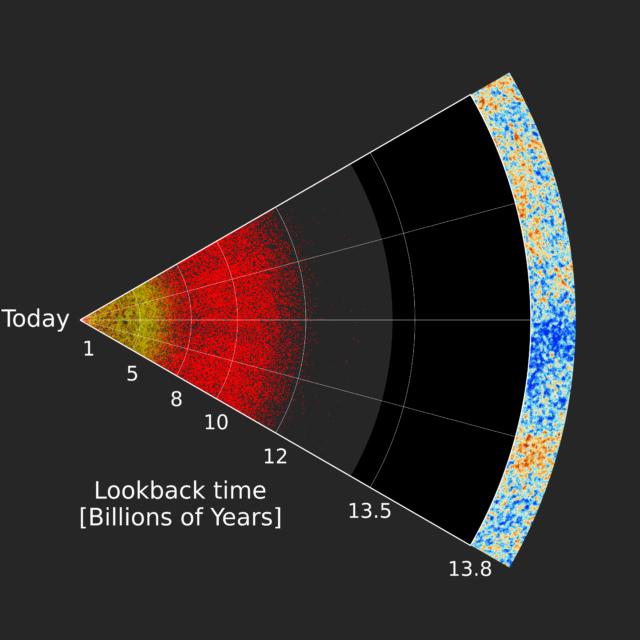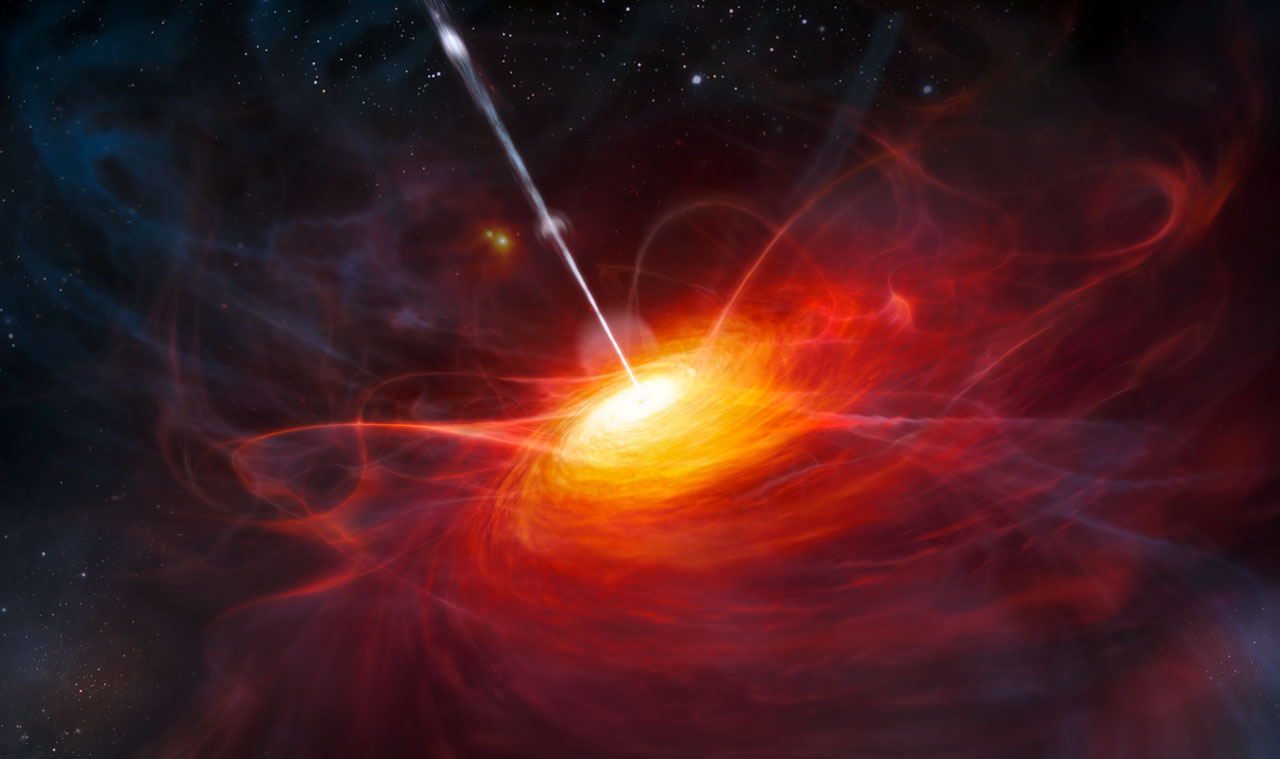
A slice through largest-ever three-dimensional map of the Universe. Earth can be seen on the left, and distances to galaxies and quasars are labelled by the lookback time to the objects (how long light from an object has been traveling to reach Earth). Locations of quasars are shown by the red dots, and nearer galaxies mapped by SDSS are also shown in yellow. The right side of the map is the limit of the observable Universe, from which we see the Cosmic Microwave Background (CMB) – remains of the Big Bang. Most of the space in between the quasars and the edge of the observable universe are from before most stars, galaxies, or quasars were formed. (Anand Raichoor, École polytechnique fédérale de Lausanne, Switzerland and the SDSS collaboration)
A team of astronomers working with the Sloan Digital Sky Survey (SDSS) created the largest ever three-dimensional map of the universe.
Released along with an accompanying study, the astronomers say the new map is the first to exclusively use the positions of quasars to chart the significant structures of the Universe.
“Because quasars are so bright, we can see them all the way across the Universe,” said study co-leader Ashley Ross, from Ohio State University in a press release. “That makes them the ideal objects to use to make the biggest map yet,” he added.
Quasars are large compacted masses surrounding enormous black holes at the center of distant galaxies. They discharge an incredible amount of energy in the form of visible light or infrared radiation.
Quasars go through periods of extreme brightness which can last anywhere from 10 to 100 million years.
These distant dazzling objects are generated when vast amounts of matter and energy fall into the giant black hole. Material from the surrounding accretion disk is pulled in so eagerly by the black hole’s gravity that it reaches incredibly high temperatures, which in turn produces a bright glow.
The study’s other co-leader, Gongbo Zhao, from the Chinese Academy of Sciences says the quasars are so distant that their light was first generated between three to seven billion years after the big bang (13.8 billion years ago) a long time before Earth was formed (about 4.5 billion years ago).

Artist’s impression of a very distant quasar powered by a black hole with a mass two billion times that of the Sun. (ESO/M. Kornmesser via Wikimedia Commons)
Scientists with the Sloan Digital Sky Survey’s Extended Baryon Oscilliation Survey (Eboss), used the Sloan Foundation’s main 2.5 meter telescope, located at the Apache Point Observatory in New Mexico, to observe and measure the 3D positions of a large amount of quasars.
The survey measured more than 147,000 quasars in just the first two years of the project.
These observations provided the team with information of the quasars’ distances, which was used to mark their positions on the three-dimensional map of the universe.
“Our results are consistent with Einstein’s theory of General Relativity” said Hector Gil-Marin, a researcher from the Laboratory of Nuclear Physics and High Energies in Paris who took on important segments of the analysis.
























I had a weird dream last night. I dreamed that we are the neurons in Gods brain and the synapses all look like the Universe! The webbing and stars and galaxies are all there and empty space was a viscous light fluid. You may think i am crazy but i have a 130 IQ and i have never had a dream like this before. It is kind of scary to think that we could be the conscious inside of another creature (God or Alien)!
Sure they are, next thing you’re probably going to try to tell us is that the moon is not made of Swiss cheese, who do you think you are fooling, not this guy
the map is a little misleading in that the about 2 billion years pre-quasar/star makes up a huge segment of he map, whereas it really is a small interval of time in the log of the universe
The whole universe is filled with Primordial Quantum Bosons (PQBs). These Bosons are of -t (minus time) and +t (plus time) type dynamic three dimensional space-time bubbles represented by PQB-t and PQB+t. The Boson PLASMA, a mixture of (PQB-t)s and (PQB+t)s propagate producing spacetime field that could be the gravitational field and of more abundant form of quantum energy that may give a clue to dark matter and darkenergy.
The whole Universe is filled with Primordial Quantum Bosons (PQBs) of minus time (-t) and plus time (+t). The mixture of these PQBs is called the Spacetime Plasma. Each PQB is a 3 dimensional dynamic tiny infinitesimally small spacetime bubble. These 3D bubbles propagate producing spacetime field that could be the gravitational field. The spacetime Plasma may be more abundant form of dynamic Quantum Energy (Vacuum energy) that may give a clue to the dark matter and dark energy.
No one knows how big the universe is but we do know it isn’t 13.8 billion years old but it is 6,020 years old.
It should read “a map of the known universe.” For all we think we know, the universe may be even larger than we imagine. We do not know what lies beyond what we can see. Let’s remember physicists cannot account for 95% of the mass of the universe and most of the energy and that’s only with the knowledge we have so far. I think in the future, physicists will be in for a very large number of surprises that will put their current understanding into a much larger context that will show that at this point in time they really know very little. For example, they cannot tell you how or why like electrical charged particles repel and oppositely charged particles attract. They cannot tell you what holds atomic nuclei together. All they can do is put a name on it calling it “the strong force.” How does it work? They don’t know.